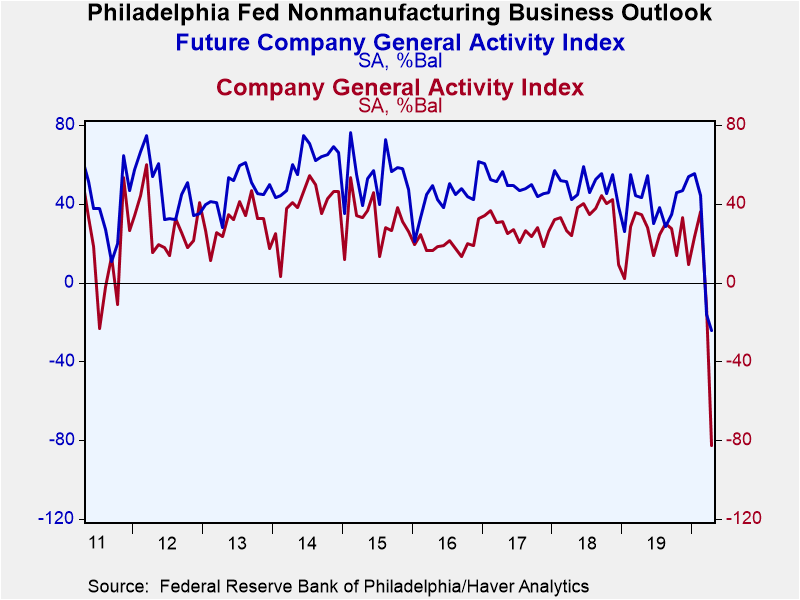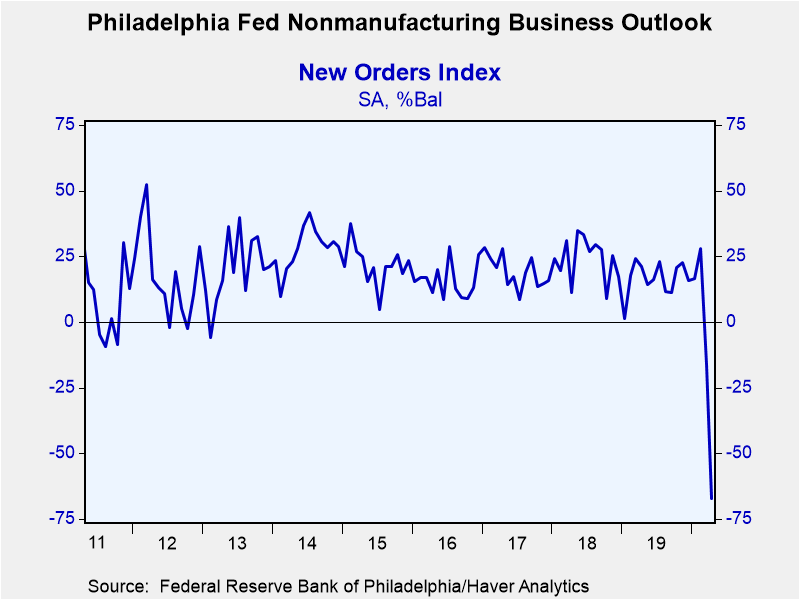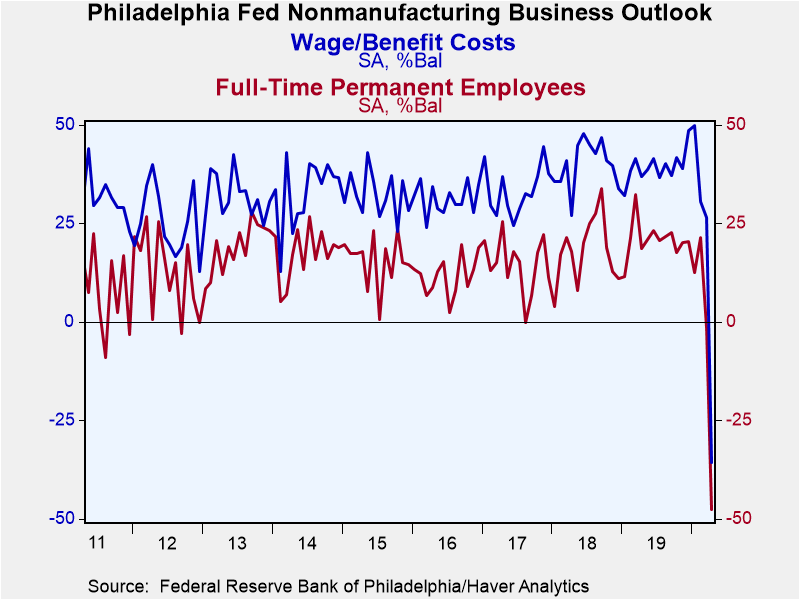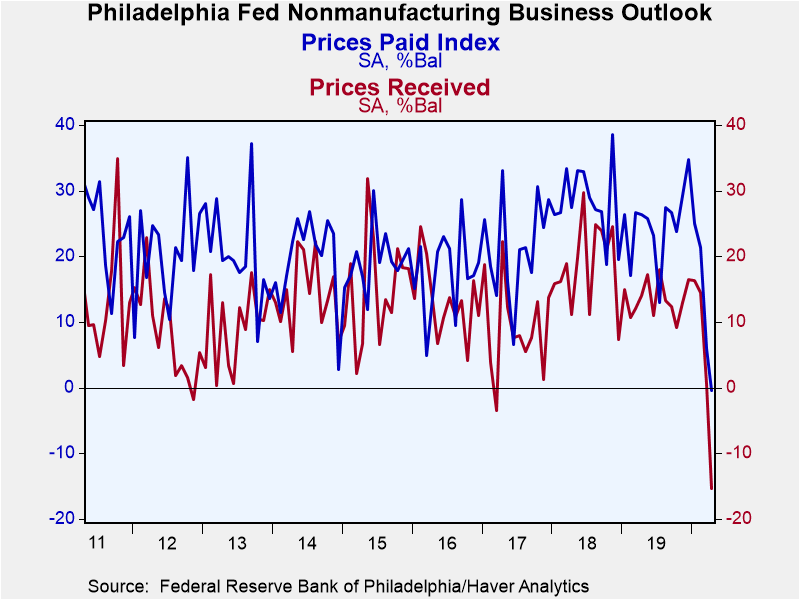 Global| Apr 21 2020
Global| Apr 21 2020Philadelphia Fed Nonmanufacturing Business Activity Collapses
by:Tom Moeller
|in:Economy in Brief
Summary
• New orders & shipments turn negative. • Employment decline weakens wages. • Prices paid fall sharply. The Federal Reserve Bank of Philadelphia reported that its Nonmanufacturing Business Index of current activity at the company [...]
• New orders & shipments turn negative.
• Employment decline weakens wages.
• Prices paid fall sharply.
The Federal Reserve Bank of Philadelphia reported that its Nonmanufacturing Business Index of current activity at the company level dropped to -82.5 during April after weakening to -12.8 in March. The index of expected general activity similarly remained negative at -24.5.
Components of the company general activity index were all weak this month. New orders figures collapsed to -67.2 as only 0.3% of firms reported improved new orders while a greatly increased 68% reported a decline. The sales or revenue series fell m/m to -87.9. The index of unfilled orders also went negative but the inventories measure rose slightly.
The labor market measures unraveled in April. The full-time permanent employment measure fell to -47.5, indicating a record pace of job cutbacks. A greatly lessened 4% of firms reported increased hiring while a surging 52% reported a decline. Part-time/temporary employee hiring again was pulled back. The average workweek reading similarly dove. The wages & benefits measure turned negative.
Pricing power evaporated. The index of prices paid fell to -0.4, down from 34.7 late last year. A greatly lessened 13% of firms reported higher prices while a near-record 14% paid less. The prices received index fell well into negative territory.
The capital expenditure measures collapsed. Both the physical plant and equipment & software expenditure readings turned negative. Seven percent of respondents raised outlays on equipment while 48% lowered them.
The Philadelphia Fed figures are diffusion indexes which are calculated by subtracting the percent of respondents reporting decreases in business activity from those reporting improvement. So, readings above zero indicate more positive than negative responses. These indexes have a good correlation with growth in the series covered. The data are available in Haver's SURVEYS database.
| Federal Reserve Bank of Philadelphia: Nonmanufacturing Business Outlook Survey (Diffusion Index, SA) | Apr | Mar | Feb | Apr'19 | 2019 | 2018 | 2017 |
|---|---|---|---|---|---|---|---|
| General Activity - Company | -82.5 | -12.8 | 36.1 | 34.5 | 23.4 | 33.5 | 27.2 |
| New Orders | -67.2 | -16.4 | 28.1 | 21.0 | 16.7 | 24.2 | 19.1 |
| Sales or Revenue | -87.9 | -4.9 | 39.8 | 34.0 | 24.0 | 30.8 | 27.8 |
| Inventories | 1.9 | -1.7 | 5.6 | 2.0 | 4.0 | 5.2 | 3.8 |
| Number of Full-Time Permanent Employees | -47.5 | -1.7 | 21.5 | 18.7 | 20.9 | 18.1 | 14.8 |
| Part-Time/Temporary/Contract Employees | -58.9 | -11.2 | 10.4 | 23.1 | 14.6 | 15.5 | 12.3 |
| Prices Paid | -0.4 | 6.0 | 21.3 | 26.4 | 25.0 | 28.3 | 21.4 |
| Wage & Benefit Costs | -35.7 | 26.6 | 30.7 | 37.0 | 39.4 | 40.1 | 33.5 |
| Expected General Activity - Company | -24.5 | -16.3 | 44.2 | 43.4 | 41.7 | 49.9 | 49.8 |
Tom Moeller
AuthorMore in Author Profile »Prior to joining Haver Analytics in 2000, Mr. Moeller worked as the Economist at Chancellor Capital Management from 1985 to 1999. There, he developed comprehensive economic forecasts and interpreted economic data for equity and fixed income portfolio managers. Also at Chancellor, Mr. Moeller worked as an equity analyst and was responsible for researching and rating companies in the economically sensitive automobile and housing industries for investment in Chancellor’s equity portfolio. Prior to joining Chancellor, Mr. Moeller was an Economist at Citibank from 1979 to 1984. He also analyzed pricing behavior in the metals industry for the Council on Wage and Price Stability in Washington, D.C. In 1999, Mr. Moeller received the award for most accurate forecast from the Forecasters' Club of New York. From 1990 to 1992 he was President of the New York Association for Business Economists. Mr. Moeller earned an M.B.A. in Finance from Fordham University, where he graduated in 1987. He holds a Bachelor of Arts in Economics from George Washington University.










